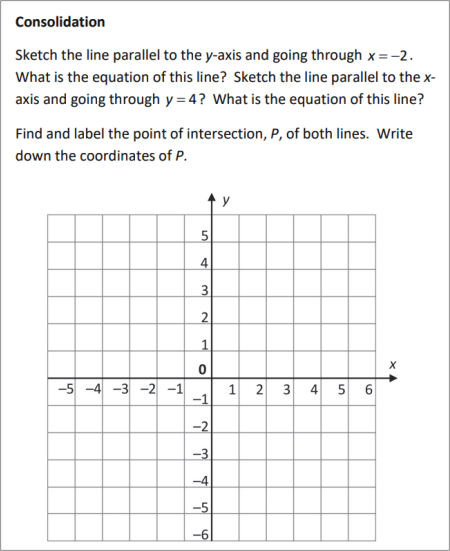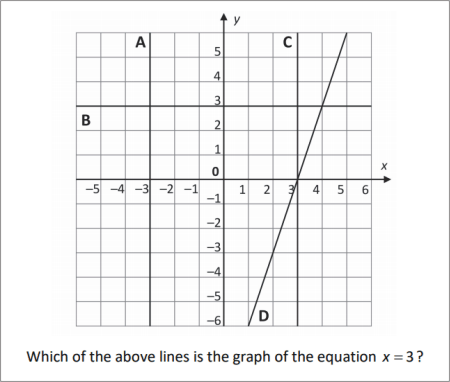|
Lines and equations |
|
|
|
To use the resources of this chapter you must first register |
|
|
CONTENTS |
|
|
|
|
|
Once you have registered, you can work through the slides one by one.
The workout comprises a series of sides that guide you systematically through the topic concept by concept, skill by skill. The slides may be used with or without the support of a tutor. The methodology is based on problem-solving that advances in logical succession by concept and difficulty. The student is presented with a problem or series of questions, and the next slide presents the fully-worked solution. To use the material you must sign-in or create an account.
blacksacademy.net comprises a complete course in mathematics with resources that are comprehensive.
|
|
|
|
SAMPLE FROM THE WORKOUT |
| Showing American English version |
SLIDE 1 - QUESTION 1 |
 |
|
SLIDE 2 - SOLUTION |
 |
|
|
SAMPLE FROM THE LIBRARY |
| Showing American English version |
QUESTION [difficulty 0.1] |
 |
|
SOLUTION |
 |
|
|
DEPENDENCIES |
|
|
|
|
CONCEPTS |
|
|
|
|
LEV. |
|
|
Positive and negative gradient, sloping up or down
|
|
612.5 |
|
|
Gradient and constant of linear proportionality
|
|
613.1 |
|
|
Intersection of three lines
|
|
613.6 |
|
|
Unique point of intersection of two non-parallel lines
|
|
613.8 |
|
|
Intercept on the y-axis
|
|
614.0 |
|
|
Common gradient of two parallel lines
|
|
614.2 |
|
|
Line defined by gradient and intercept
|
|
614.4 |
|
|
Graphical method to find point of intersection
|
|
614.6 |
|
|
Graphical method is inaccurate
|
|
614.9 |
|
|
Perpendicular distance between two lines
|
|
615.2 |
|
|
Relationship of gradients of perpendicular lines
|
|
615.6 |
|
|
Perpendicular gradient is negative reciprocal
|
|
616.0 |
|
|
|
|
RAW CONTENT OF THE WORKOUT |
|
| To make use of this chapter, please first register. Then you can work through the slides one by one. |
|
| What is provided here is the raw text of the workout. Most of the information is contained in the image files, which are not included with this text. The text may appear deceptively short. (The content overall of blacksacademy.net is vast.) Any in-line questions appear as a question mark [?]. This text is provided only as an indication of the overall quantity of material contained in the chapter. To use the material you must sign-in or create an account. |
|
| * |
|
|
SLIDE 1
Consolidation
Sketch the line parallel to the y-axis and going through . What is the equation of this line? Sketch the line parallel to the x-axis and going through ? What is the equation of this line?
Find and label the point of intersection, P, of both lines. Write down the coordinates of P.
SLIDE 2
SLIDE 3
Consolidation
Classify each of the above as (linear) proportional, linear (but not proportional) or non-linear.
SLIDE 4
SLIDE 5
Negative gradient
In a right-angled triangle the ratio of the rise to the step is called the gradient.
positive gradient negative gradient
sloping upwards sloping downwards
SLIDE 6
State for each of the above (a) whether the gradient is positive or negative, (b) whether the relationship is proportional or non-proportional. (All the relationships are linear.)
SLIDE 7
SLIDE 8
The idea of proportionality extends to the whole coordinate plane.
A proportional relationship is represented in a graph by any line passing through the origin. It may be positive (upward sloping) or negative (downward sloping).
SLIDE 9
Find the gradient of each of the above. State whether the triangle is upward or downward sloping.
SLIDE 10
? , upward sloping
? , downward sloping
? , upward sloping
? , downward sloping
? , downward sloping
SLIDE 11
In a linear proportional relationship, the gradient is the constant of proportionality.
SLIDE 12
Find the constant of proportionality and the equation of the relationship.
SLIDE 13
SLIDE 14
Find the constant of proportionality and the equation of the relationship.
SLIDE 15
SLIDE 16
Draw three lines
? so that they intersect at one point
? so that they intersect at three points
? so that they intersect at only two points
SLIDE 17
SLIDE 18
When two lines are not parallel, they intersect in the coordinate plane at a unique point of intersection.
Find the coordinates of P, the point of intersection of the two lines.
SLIDE 19
SLIDE 20
The point where a line crosses the y-axis is called the intercept on the y-axis
State the coordinates of the intercept on the y-axis of the two lines.
SLIDE 21
? Intercept or
? Intercept or
SLIDE 22
The two lines above are parallel. Find their common gradient and state the intercept on the y-axis of each.
SLIDE 23
?
?
SLIDE 24
Draw onto the coordinate plane the line with gradient 1 and intercept at .
SLIDE 25
Line with gradient 1 (1 in 1) and intercept at
SLIDE 26
Draw onto the coordinate plane two lines
? with gradient 2 and intercept at
? with gradient and intercept at
Find their point of intersection.
SLIDE 27
SLIDE 28
Graphical method of finding the point of intersection of two lines
By drawing a horizontal line and a vertical line, find to 1 decimal place the coordinates of the point of intersection of the two lines. What is the degree of accuracy of this method? To what degree of certainty do we know the answer to the question: what is the point of intersection of the two lines?
SLIDE 29
To 1 decimal place the point of intersection is . This method involves “judging by eye”. As a result, your solution may differ from the above one by 0.1 either way.
This method is not accurate. You have an “idea” of where the point of intersection lies, but you are not certain that your solution is exact.
SLIDE 30
Draw onto the coordinate plane two lines
? with gradient 3 and intercept at
? with gradient and intercept at
Find by eye the point of intersection, giving your answer to 1 decimal place.
SLIDE 31
? with gradient 3 and intercept at
? with gradient and intercept at
By eye, the point of intersection is . The degree of accuracy is, say, 0.1.
SLIDE 32
? Draw onto the coordinate plane a line with gradient with gradient and intercept at .
? Draw another line parallel to the first line, with intercept at
? Draw a line perpendicular to both lines anywhere on the diagram. Using Pythagoras, find this perpendicular distance, giving your answer to 1 decimal place.
SLIDE 33
The base and height of the line perpendicular to both parallel lines is 3.3 and 4.8 respectively, to 0.1 degree of accuracy.
By Pythagoras’s Theorem
.
SLIDE 34
Draw onto the coordinate plane a line passing through the points and . Find its gradient, and use the graph to find the intercept on the y-axis.
SLIDE 35
From the graph, the intercept is at
SLIDE 36
? Find the gradient of the hypotenuse. Draw the (infinitely long) line passing through the points and . Find the gradient of this line.
? Rotate the triangle 90° clockwise about the point .
? Draw the line perpendicular to the line PQ you have just drawn passing through . What is the gradient of this perpendicular line?
SLIDE 37
The gradient of the line PQ is .
The line that is perpendicular to PQ has the same gradient as the triangle that has been rotated 90°. The gradient is .
SLIDE 38
? Draw the line with gradient and intercept
? Draw the perpendicular to the line you have just drawn passing through the point .
? Mark the point of intersection, Q, of the two perpendicular lines and find the coordinates of Q giving your answer to 0.1 decimal places. State the degree of accuracy of the coordinates of Q.
SLIDE 39
The coordinates of the point of intersection are .
The degree of accuracy is 0.1 at best.
SLIDE 40
The gradient of a line is . The gradient of the line perpendicular to this line is the negative reciprocal of this gradient. It is .
Exercise
Find the gradient of the line perpendicular to the line with gradient
? ? ?
? ? ?
SLIDE 41
? perpendicular gradient
? perpendicular gradient
? perpendicular gradient
? perpendicular gradient
? perpendicular gradient 5
? perpendicular gradient
|
|